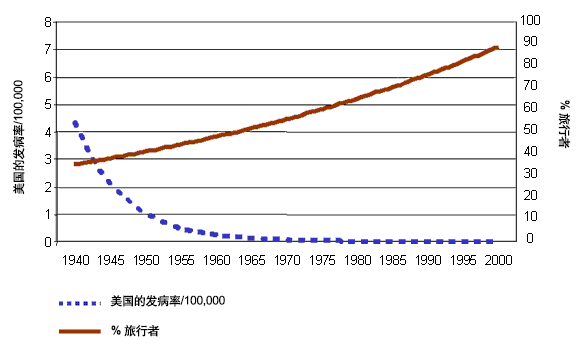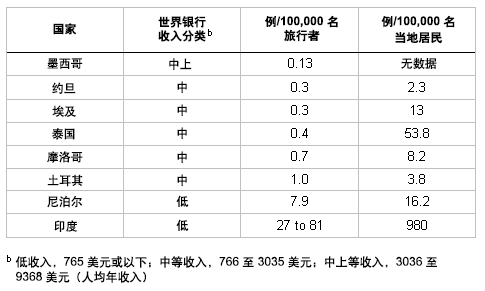根据 2014 年的估计,全世界每年约有 2100 万例伤寒病例,并且有 222,000 例与伤寒有关的死亡病例。[1]World Health Organization. Typhoid. April 2015. [internet publication]http://www.who.int/immunization/diseases/typhoid/en/来自全球疾病负担研究的数据显示,大多数已被报道的伤寒病例来自于印度次大陆。[2]DeRoeck D, Jodar L, Clemens J. Putting typhoid vaccination on the global health agenda. N Engl J Med. 2007;357:1069-1071.http://www.ncbi.nlm.nih.gov/pubmed/17855666?tool=bestpractice.com[3]Wain J, Hendriksen RS, Mikoleit ML, et al. Typhoid fever. Lancet. 2015 Mar 21;385(9973):1136-45.http://www.thelancet.com/journals/lancet/article/PIIS0140-6736(13)62708-7/fulltexthttp://www.ncbi.nlm.nih.gov/pubmed/25458731?tool=bestpractice.com [Figure caption and citation for the preceding image starts]: 世界各地伤寒感染年发病率美国疾病控制与预防中心 (CDC) 图像库 [Citation ends].
[Figure caption and citation for the preceding image starts]: 世界各地伤寒感染年发病率美国疾病控制与预防中心 (CDC) 图像库 [Citation ends].
据报告,越南湄公河三角洲地区的年发病率高达 198 例/100,000 人,[4]Lin FY, Vo HA, Phan VB, et al. The epidemiology of typhoid fever in the Dong Thap Province, Mekong Delta region of Vietnam. Am J Trop Med Hyg. 2000;62:644-648.http://www.ajtmh.org/content/62/5/644.full.pdf+htmlhttp://www.ncbi.nlm.nih.gov/pubmed/11289678?tool=bestpractice.com 而印度德里的年发病率[5]Sinha A, Sazawal S, Kumar R, et al. Typhoid fever in children less than 5 years. Lancet. 1999;354:734-737.http://www.ncbi.nlm.nih.gov/pubmed/10475185?tool=bestpractice.com 为 980 例/100,000 人。在这些地区,5 到 15 岁学龄儿童的发病率较高,但 5 岁以下儿童的发病率也较高。[6]Ivanoff B, Levine MM, Lambert PH. Vaccination against typhoid fever: present status. Bull World Health Organ. 1994:72:957-971.http://www.ncbi.nlm.nih.gov/pubmed/7867143?tool=bestpractice.com 即使在一个国家或城市内,发病率也可能差异较大,其中受影响的主要为城市贫民区。[2]DeRoeck D, Jodar L, Clemens J. Putting typhoid vaccination on the global health agenda. N Engl J Med. 2007;357:1069-1071.http://www.ncbi.nlm.nih.gov/pubmed/17855666?tool=bestpractice.com 在伤寒感染曾经流行的发达国家,疾病模式发生了两个重大变化。 首先,发病率在过去半个世纪显著下降;其次,该病成为一种主要与旅行相关的疾病。  [Figure caption and citation for the preceding image starts]: 伤寒感染发病率(左)和旅行者百分比(右)美国疾病控制与预防中心 (CDC) 图像库 [Citation ends]. 例如,在美国,伤寒感染年发病率在 1940 年为 7.5/100,000,20 世纪 90 年代则跌至 0.2/100,000;与国外旅行有关的病例比例在 1967 年为 33%,在 1996 年到 1997 年则增加至 72% 到 81%。[7]Mermin JH, Townes JM, Gerber M, et al. Typhoid fever in the United States, 1985-1994: changing risks of international travel and increasing antimicrobial resistance. Arch Intern Med. 1998;158:633-638.http://archinte.jamanetwork.com/article.aspx?articleid=191653http://www.ncbi.nlm.nih.gov/pubmed/9521228?tool=bestpractice.com[8]Taylor DN, Pollard RA, Blake PA. Typhoid in the United States and the risk to the international traveler. J Infect Dis. 1983;148:599-602.http://www.ncbi.nlm.nih.gov/pubmed/6311917?tool=bestpractice.com[9]Ryan CA, Hargrett-Bean NT, Blake PA. Salmonella typhi infections in the United States, 1975-1984: increasing role of foreign travel. Rev Infect Dis. 1989;11:1-8.http://www.ncbi.nlm.nih.gov/pubmed/2916092?tool=bestpractice.com 在以色列,该病的变化甚至更显著,20 世纪 50 年代早期年发病率为 90/100,000,而在 2003 年则跌至 0.23/100,000;这些病例中有 57% 为从国外获得的感染。[10]Meltzer E, Yossepowitch O, Sadik C, et al. Epidemiology and clinical aspects of enteric fever in Israel. Am J Trop Med Hyg. 2006;74:540-545.http://www.ajtmh.org/content/74/4/540.fullhttp://www.ncbi.nlm.nih.gov/pubmed/16606981?tool=bestpractice.com 过去十年,工业化国家报告的年发病率总体范围介于 0.13 到 1.2 例/ 10 万,绝大多数为输入性。[7]Mermin JH, Townes JM, Gerber M, et al. Typhoid fever in the United States, 1985-1994: changing risks of international travel and increasing antimicrobial resistance. Arch Intern Med. 1998;158:633-638.http://archinte.jamanetwork.com/article.aspx?articleid=191653http://www.ncbi.nlm.nih.gov/pubmed/9521228?tool=bestpractice.com[11]Lester A, Mygind O, Jensen KT, et al. Typhoid and paratyphoid fever in Denmark 1986-1990: epidemiologic aspects and the extent of bacteriological follow-up of patients. Ugeskr Laeger. 1994;156:3770-3775.http://www.ncbi.nlm.nih.gov/pubmed/8059456?tool=bestpractice.com[12]Yew FS, Goh KT, Lim YS. Epidemiology of typhoid fever in Singapore. Epidemiol Infect. 1993;110:63-70.http://www.ncbi.nlm.nih.gov/pubmed/8432324?tool=bestpractice.com 旅行者的风险因造访的地区而有所不同。[13]Crump JA, Luby SP, Mintz ED. The global burden of typhoid fever. Bull World Health Organ. 2004;82:346-353.http://www.ncbi.nlm.nih.gov/pubmed/15298225?tool=bestpractice.com[14]Acharya IL, Lowe CU, Thapa R, et al. Prevention of typhoid fever in Nepal with the Vi capsular polysaccharide of Salmonella typhi. A preliminary report. N Engl J Med. 1987;317:1101-1104.http://www.ncbi.nlm.nih.gov/pubmed/3657877?tool=bestpractice.com
[Figure caption and citation for the preceding image starts]: 伤寒感染发病率(左)和旅行者百分比(右)美国疾病控制与预防中心 (CDC) 图像库 [Citation ends]. 例如,在美国,伤寒感染年发病率在 1940 年为 7.5/100,000,20 世纪 90 年代则跌至 0.2/100,000;与国外旅行有关的病例比例在 1967 年为 33%,在 1996 年到 1997 年则增加至 72% 到 81%。[7]Mermin JH, Townes JM, Gerber M, et al. Typhoid fever in the United States, 1985-1994: changing risks of international travel and increasing antimicrobial resistance. Arch Intern Med. 1998;158:633-638.http://archinte.jamanetwork.com/article.aspx?articleid=191653http://www.ncbi.nlm.nih.gov/pubmed/9521228?tool=bestpractice.com[8]Taylor DN, Pollard RA, Blake PA. Typhoid in the United States and the risk to the international traveler. J Infect Dis. 1983;148:599-602.http://www.ncbi.nlm.nih.gov/pubmed/6311917?tool=bestpractice.com[9]Ryan CA, Hargrett-Bean NT, Blake PA. Salmonella typhi infections in the United States, 1975-1984: increasing role of foreign travel. Rev Infect Dis. 1989;11:1-8.http://www.ncbi.nlm.nih.gov/pubmed/2916092?tool=bestpractice.com 在以色列,该病的变化甚至更显著,20 世纪 50 年代早期年发病率为 90/100,000,而在 2003 年则跌至 0.23/100,000;这些病例中有 57% 为从国外获得的感染。[10]Meltzer E, Yossepowitch O, Sadik C, et al. Epidemiology and clinical aspects of enteric fever in Israel. Am J Trop Med Hyg. 2006;74:540-545.http://www.ajtmh.org/content/74/4/540.fullhttp://www.ncbi.nlm.nih.gov/pubmed/16606981?tool=bestpractice.com 过去十年,工业化国家报告的年发病率总体范围介于 0.13 到 1.2 例/ 10 万,绝大多数为输入性。[7]Mermin JH, Townes JM, Gerber M, et al. Typhoid fever in the United States, 1985-1994: changing risks of international travel and increasing antimicrobial resistance. Arch Intern Med. 1998;158:633-638.http://archinte.jamanetwork.com/article.aspx?articleid=191653http://www.ncbi.nlm.nih.gov/pubmed/9521228?tool=bestpractice.com[11]Lester A, Mygind O, Jensen KT, et al. Typhoid and paratyphoid fever in Denmark 1986-1990: epidemiologic aspects and the extent of bacteriological follow-up of patients. Ugeskr Laeger. 1994;156:3770-3775.http://www.ncbi.nlm.nih.gov/pubmed/8059456?tool=bestpractice.com[12]Yew FS, Goh KT, Lim YS. Epidemiology of typhoid fever in Singapore. Epidemiol Infect. 1993;110:63-70.http://www.ncbi.nlm.nih.gov/pubmed/8432324?tool=bestpractice.com 旅行者的风险因造访的地区而有所不同。[13]Crump JA, Luby SP, Mintz ED. The global burden of typhoid fever. Bull World Health Organ. 2004;82:346-353.http://www.ncbi.nlm.nih.gov/pubmed/15298225?tool=bestpractice.com[14]Acharya IL, Lowe CU, Thapa R, et al. Prevention of typhoid fever in Nepal with the Vi capsular polysaccharide of Salmonella typhi. A preliminary report. N Engl J Med. 1987;317:1101-1104.http://www.ncbi.nlm.nih.gov/pubmed/3657877?tool=bestpractice.com [Figure caption and citation for the preceding image starts]: 到特定目的地旅行的以色列和美国旅行者中伤寒感染发病率与当地居民发病率对比美国疾病控制与预防中心 (CDC) 图像库 [Citation ends]. 几项报告指出,印度次大陆是获得伤寒感染风险最高的地区。例如,1985 年到 1994 年间,在到墨西哥的美国旅行者中,伤寒感染发病率从 0.19/100,000 降至 0.13/100,000;而在到印度次大陆的旅行者中,发病率则从 23.4/100,000 增至 81.2/100,000。在到印度次大陆的旅行者中,伤寒感染的总风险是到其他地区旅行者的 18 倍。[7]Mermin JH, Townes JM, Gerber M, et al. Typhoid fever in the United States, 1985-1994: changing risks of international travel and increasing antimicrobial resistance. Arch Intern Med. 1998;158:633-638.http://archinte.jamanetwork.com/article.aspx?articleid=191653http://www.ncbi.nlm.nih.gov/pubmed/9521228?tool=bestpractice.com 英国数据显示类似趋势。 对 1996 年到 1998 年英格兰西北部地区病例的回顾研究发现,在 47 例输入性病例中,85% 与去印度或巴基斯坦旅行有关;而在英格兰和威尔士 200 例病例回顾研究发现,80% 的海外感染病例与到印度次大陆旅行有关。[15]Lighton LL. Follow up in north west England of cases of enteric fever acquired abroad, April 1996 to March 1998. Commun Dis Public Health. 1999;2:145-146.http://www.ncbi.nlm.nih.gov/pubmed/10402753?tool=bestpractice.com[16]UK Department of Health. Typhoid. In: Salisbury DM, Begg NT, eds. Immunisation against infectious disease. London, UK: HMSO; 1996:243-249. 来自英国的另一份报告指出,75% 的伤寒感染病例发生在旅行者中,据估计,印度次大陆旅行后发生伤寒感染的风险为 30 例/100,000 次旅行,相比之下,伤寒感染的全球风险为 1 例/100,000 次旅行。[17]Behrens R, Carroll B. The 10 year trend of travel associated infections imported into the U.K. Proceedings of the 7th Conference of the International Society of Travel Medicine (CISTM7), Innsbruck; 2001:86. 在以色列,74% 的输入性伤寒感染病例是在印度感染,经计算,罹患率为 24/10 万名旅行者,这一数字是泰国或中东地区旅行者的 100 倍。[18]Meltzer E, Sadik C, Schwartz E. Enteric fever in Israeli travelers: a nationwide study. J Travel Med. 2005;12:275-281.http://www.ncbi.nlm.nih.gov/pubmed/16256052?tool=bestpractice.com 来自法国和德国的报告也指出,印度次大陆为主要的地理来源。[19]Caumes E, Ehya N, Nguyen J, et al. Typhoid and paratyphoid fever: a 10-year retrospective study of 41 cases in a Parisian hospital. J Travel Med. 2001;8:293-297.http://www.ncbi.nlm.nih.gov/pubmed/11726293?tool=bestpractice.com[20]Jelinek T, Nothdurft HD, von Sonnenburg F, et al. Risk factors for typhoid fever in travelers. J Travel Med. 1996;3:200-203.http://www.ncbi.nlm.nih.gov/pubmed/9815456?tool=bestpractice.com
[Figure caption and citation for the preceding image starts]: 到特定目的地旅行的以色列和美国旅行者中伤寒感染发病率与当地居民发病率对比美国疾病控制与预防中心 (CDC) 图像库 [Citation ends]. 几项报告指出,印度次大陆是获得伤寒感染风险最高的地区。例如,1985 年到 1994 年间,在到墨西哥的美国旅行者中,伤寒感染发病率从 0.19/100,000 降至 0.13/100,000;而在到印度次大陆的旅行者中,发病率则从 23.4/100,000 增至 81.2/100,000。在到印度次大陆的旅行者中,伤寒感染的总风险是到其他地区旅行者的 18 倍。[7]Mermin JH, Townes JM, Gerber M, et al. Typhoid fever in the United States, 1985-1994: changing risks of international travel and increasing antimicrobial resistance. Arch Intern Med. 1998;158:633-638.http://archinte.jamanetwork.com/article.aspx?articleid=191653http://www.ncbi.nlm.nih.gov/pubmed/9521228?tool=bestpractice.com 英国数据显示类似趋势。 对 1996 年到 1998 年英格兰西北部地区病例的回顾研究发现,在 47 例输入性病例中,85% 与去印度或巴基斯坦旅行有关;而在英格兰和威尔士 200 例病例回顾研究发现,80% 的海外感染病例与到印度次大陆旅行有关。[15]Lighton LL. Follow up in north west England of cases of enteric fever acquired abroad, April 1996 to March 1998. Commun Dis Public Health. 1999;2:145-146.http://www.ncbi.nlm.nih.gov/pubmed/10402753?tool=bestpractice.com[16]UK Department of Health. Typhoid. In: Salisbury DM, Begg NT, eds. Immunisation against infectious disease. London, UK: HMSO; 1996:243-249. 来自英国的另一份报告指出,75% 的伤寒感染病例发生在旅行者中,据估计,印度次大陆旅行后发生伤寒感染的风险为 30 例/100,000 次旅行,相比之下,伤寒感染的全球风险为 1 例/100,000 次旅行。[17]Behrens R, Carroll B. The 10 year trend of travel associated infections imported into the U.K. Proceedings of the 7th Conference of the International Society of Travel Medicine (CISTM7), Innsbruck; 2001:86. 在以色列,74% 的输入性伤寒感染病例是在印度感染,经计算,罹患率为 24/10 万名旅行者,这一数字是泰国或中东地区旅行者的 100 倍。[18]Meltzer E, Sadik C, Schwartz E. Enteric fever in Israeli travelers: a nationwide study. J Travel Med. 2005;12:275-281.http://www.ncbi.nlm.nih.gov/pubmed/16256052?tool=bestpractice.com 来自法国和德国的报告也指出,印度次大陆为主要的地理来源。[19]Caumes E, Ehya N, Nguyen J, et al. Typhoid and paratyphoid fever: a 10-year retrospective study of 41 cases in a Parisian hospital. J Travel Med. 2001;8:293-297.http://www.ncbi.nlm.nih.gov/pubmed/11726293?tool=bestpractice.com[20]Jelinek T, Nothdurft HD, von Sonnenburg F, et al. Risk factors for typhoid fever in travelers. J Travel Med. 1996;3:200-203.http://www.ncbi.nlm.nih.gov/pubmed/9815456?tool=bestpractice.com
风险增加的特殊群体是拜访亲友的旅行者 (VFR):即,回家乡度假的移民。 VFR 旅行者去农村地区旅行的几率更高,此外,他们不太可能收到旅行前忠告,不太可能遵守食物和水的注意事项,旅行之前不太可能接种伤寒疫苗。[21]Angell SY, Cetron MS. Health disparities among travelers visiting friends and relatives abroad. Ann Intern Med. 2005;142:67-72.http://annals.org/article.aspx?articleid=718052http://www.ncbi.nlm.nih.gov/pubmed/15630110?tool=bestpractice.com
死亡在短期旅行者中罕见。 对 1985 年到 1994 年美国疾病控制与预防中心 (CDC) 监测数据进行回顾,发现 2445 例伤寒病例的死亡率为 0.4%。 死亡只见于移民,而非短期旅行者。[7]Mermin JH, Townes JM, Gerber M, et al. Typhoid fever in the United States, 1985-1994: changing risks of international travel and increasing antimicrobial resistance. Arch Intern Med. 1998;158:633-638.http://archinte.jamanetwork.com/article.aspx?articleid=191653http://www.ncbi.nlm.nih.gov/pubmed/9521228?tool=bestpractice.com 在法国、德国、以色列及尼泊尔,旅行回来后住院的伤寒感染无死亡。[18]Meltzer E, Sadik C, Schwartz E. Enteric fever in Israeli travelers: a nationwide study. J Travel Med. 2005;12:275-281.http://www.ncbi.nlm.nih.gov/pubmed/16256052?tool=bestpractice.com[19]Caumes E, Ehya N, Nguyen J, et al. Typhoid and paratyphoid fever: a 10-year retrospective study of 41 cases in a Parisian hospital. J Travel Med. 2001;8:293-297.http://www.ncbi.nlm.nih.gov/pubmed/11726293?tool=bestpractice.com[20]Jelinek T, Nothdurft HD, von Sonnenburg F, et al. Risk factors for typhoid fever in travelers. J Travel Med. 1996;3:200-203.http://www.ncbi.nlm.nih.gov/pubmed/9815456?tool=bestpractice.com[22]Shlim DR, Schwartz E, Eaton M. Clinical importance of Salmonella paratyphi A infection to enteric fever in Nepal. J Travel Med. 1995;2:165-168.http://www.ncbi.nlm.nih.gov/pubmed/9815378?tool=bestpractice.com
 [Figure caption and citation for the preceding image starts]: 世界各地伤寒感染年发病率美国疾病控制与预防中心 (CDC) 图像库 [Citation ends].
[Figure caption and citation for the preceding image starts]: 世界各地伤寒感染年发病率美国疾病控制与预防中心 (CDC) 图像库 [Citation ends]. [Figure caption and citation for the preceding image starts]: 伤寒感染发病率(左)和旅行者百分比(右)美国疾病控制与预防中心 (CDC) 图像库 [Citation ends]. 例如,在美国,伤寒感染年发病率在 1940 年为 7.5/100,000,20 世纪 90 年代则跌至 0.2/100,000;与国外旅行有关的病例比例在 1967 年为 33%,在 1996 年到 1997 年则增加至 72% 到 81%。[7][8][9] 在以色列,该病的变化甚至更显著,20 世纪 50 年代早期年发病率为 90/100,000,而在 2003 年则跌至 0.23/100,000;这些病例中有 57% 为从国外获得的感染。[10] 过去十年,工业化国家报告的年发病率总体范围介于 0.13 到 1.2 例/ 10 万,绝大多数为输入性。[7][11][12] 旅行者的风险因造访的地区而有所不同。[13][14]
[Figure caption and citation for the preceding image starts]: 伤寒感染发病率(左)和旅行者百分比(右)美国疾病控制与预防中心 (CDC) 图像库 [Citation ends]. 例如,在美国,伤寒感染年发病率在 1940 年为 7.5/100,000,20 世纪 90 年代则跌至 0.2/100,000;与国外旅行有关的病例比例在 1967 年为 33%,在 1996 年到 1997 年则增加至 72% 到 81%。[7][8][9] 在以色列,该病的变化甚至更显著,20 世纪 50 年代早期年发病率为 90/100,000,而在 2003 年则跌至 0.23/100,000;这些病例中有 57% 为从国外获得的感染。[10] 过去十年,工业化国家报告的年发病率总体范围介于 0.13 到 1.2 例/ 10 万,绝大多数为输入性。[7][11][12] 旅行者的风险因造访的地区而有所不同。[13][14] [Figure caption and citation for the preceding image starts]: 到特定目的地旅行的以色列和美国旅行者中伤寒感染发病率与当地居民发病率对比美国疾病控制与预防中心 (CDC) 图像库 [Citation ends]. 几项报告指出,印度次大陆是获得伤寒感染风险最高的地区。例如,1985 年到 1994 年间,在到墨西哥的美国旅行者中,伤寒感染发病率从 0.19/100,000 降至 0.13/100,000;而在到印度次大陆的旅行者中,发病率则从 23.4/100,000 增至 81.2/100,000。在到印度次大陆的旅行者中,伤寒感染的总风险是到其他地区旅行者的 18 倍。[7] 英国数据显示类似趋势。 对 1996 年到 1998 年英格兰西北部地区病例的回顾研究发现,在 47 例输入性病例中,85% 与去印度或巴基斯坦旅行有关;而在英格兰和威尔士 200 例病例回顾研究发现,80% 的海外感染病例与到印度次大陆旅行有关。[15][16] 来自英国的另一份报告指出,75% 的伤寒感染病例发生在旅行者中,据估计,印度次大陆旅行后发生伤寒感染的风险为 30 例/100,000 次旅行,相比之下,伤寒感染的全球风险为 1 例/100,000 次旅行。[17] 在以色列,74% 的输入性伤寒感染病例是在印度感染,经计算,罹患率为 24/10 万名旅行者,这一数字是泰国或中东地区旅行者的 100 倍。[18] 来自法国和德国的报告也指出,印度次大陆为主要的地理来源。[19][20]
[Figure caption and citation for the preceding image starts]: 到特定目的地旅行的以色列和美国旅行者中伤寒感染发病率与当地居民发病率对比美国疾病控制与预防中心 (CDC) 图像库 [Citation ends]. 几项报告指出,印度次大陆是获得伤寒感染风险最高的地区。例如,1985 年到 1994 年间,在到墨西哥的美国旅行者中,伤寒感染发病率从 0.19/100,000 降至 0.13/100,000;而在到印度次大陆的旅行者中,发病率则从 23.4/100,000 增至 81.2/100,000。在到印度次大陆的旅行者中,伤寒感染的总风险是到其他地区旅行者的 18 倍。[7] 英国数据显示类似趋势。 对 1996 年到 1998 年英格兰西北部地区病例的回顾研究发现,在 47 例输入性病例中,85% 与去印度或巴基斯坦旅行有关;而在英格兰和威尔士 200 例病例回顾研究发现,80% 的海外感染病例与到印度次大陆旅行有关。[15][16] 来自英国的另一份报告指出,75% 的伤寒感染病例发生在旅行者中,据估计,印度次大陆旅行后发生伤寒感染的风险为 30 例/100,000 次旅行,相比之下,伤寒感染的全球风险为 1 例/100,000 次旅行。[17] 在以色列,74% 的输入性伤寒感染病例是在印度感染,经计算,罹患率为 24/10 万名旅行者,这一数字是泰国或中东地区旅行者的 100 倍。[18] 来自法国和德国的报告也指出,印度次大陆为主要的地理来源。[19][20]